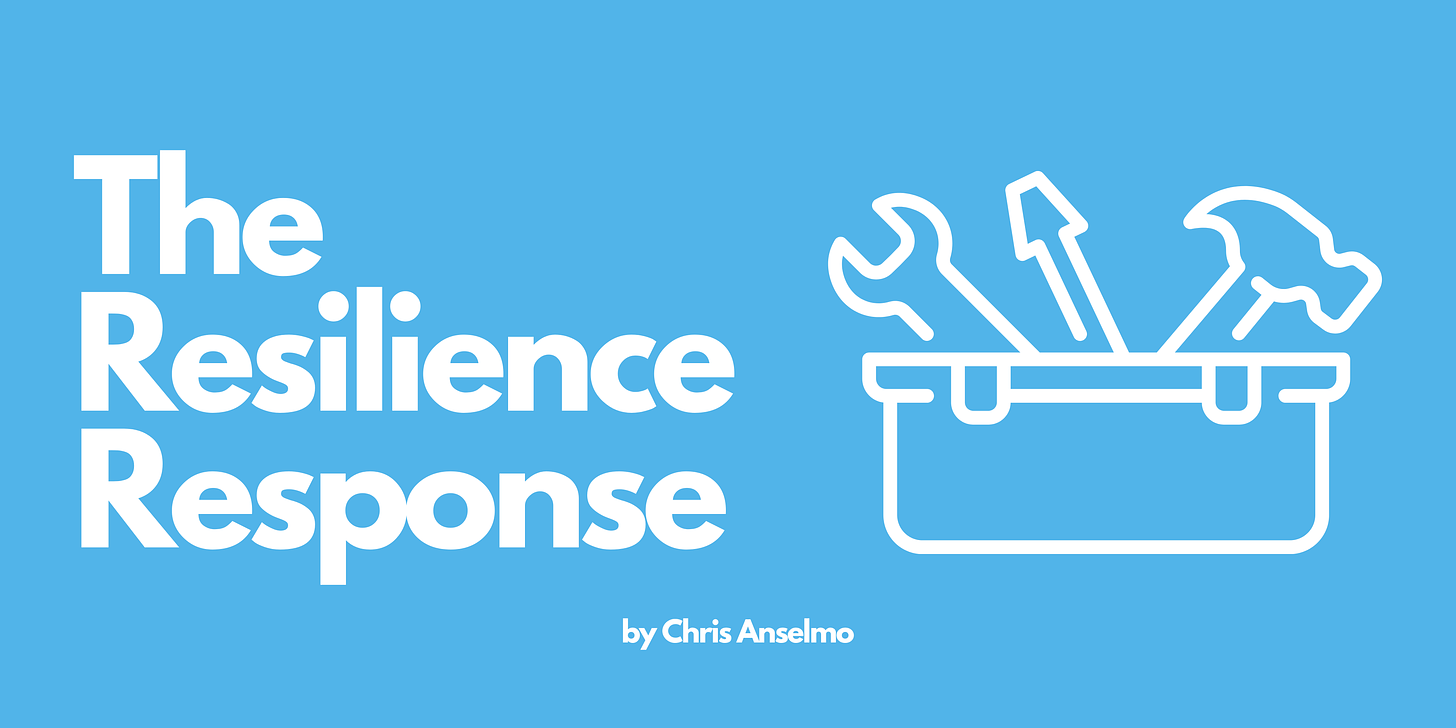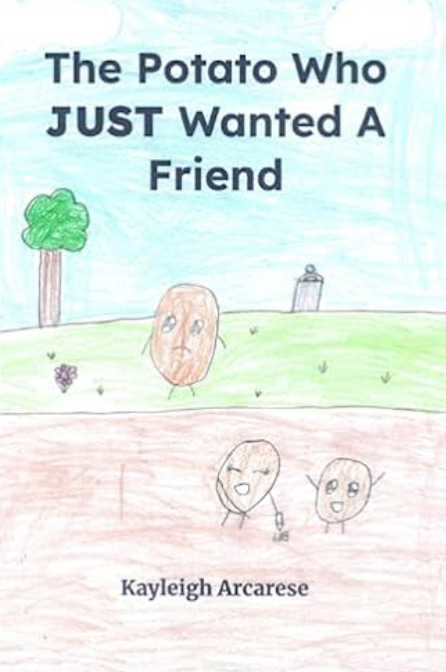The Resilience Response #3 - September 9, 2023
The positive benefits of negative visualization, an NBA All-Star writes about his mental health journey, daily readers, a potato befriending a tomato, and more
Happy Saturday!
Welcome to The Resilience Response, a newsletter that provides the tools and resources you need to face adversity with confidence.
Thank you to everyone who has supported Hello, Adversity with a paid subscription thus far. Your support means the world to me! (And for those on the fence, my birthday is next week 😉.)
Here’s what’s on deck this week:
🔧 For the Toolkit: How negative visualization can help us feel grateful and enhance our preparation
🎙️ In the First Person: NBA All-Star Kevin Love writes about what he learned after an on-court panic attack in 2017
📚 What’s Helped Me: Starting the day with a daily reader
✍️ Weekly Intention: Small steps you can take to incorporate negative visualization into your daily routine
🎁 Outtakes and Extras: A 9-year-old girl writes a heartfelt book on friendship, and a few assorted links
🔧 For the Toolkit: The power of negative visualization

When we think about all the scary events that might happen in the future, we often feel heightened anxiety and fear. Although we can’t eliminate our worries, we can use them to our advantage.
Negative visualization is a technique that takes fearful “what-if?” scenarios and transforms them into something productive. It challenges us to dwell on worst-case scenarios before they happen and grapple with their impact. In doing so, we are better able to face the future and appreciate the present moment.
Negative visualization has two distinct benefits:
First, it makes us grateful for what we have. Think about all the good things in your life, whether it’s your health, your family and friends, your job, or something else.
Now think about, in as much detail as possible, what it would be like to lose these things.
I realize this is a tough ask. It might be terrifying to think about losing a family member or getting sick, but it’s by contemplating these fearful scenarios that we gain a new appreciation for what we still have. We always focus on what’s missing in our lives without taking time to appreciate the many blessings hiding in plain sight.
When we know what could happen, we see the present in a new light. Suddenly, the mundane job or the annoying family member doesn’t seem so bad.
The second benefit of negative visualization is that it enhances our preparation. As much as we desire smooth sailing in life, we are guaranteed to eventually face choppy seas. The more we can plan for future obstacles today, the more prepared we will be to face them tomorrow.
Negative visualization also helps us prepare for less cataclysmic situations, such as an upcoming presentation or work project. When we think ahead of time about all the ways something could go wrong, such as IT issues, we can come ready with backup plans. If disaster strikes, we know what to do.
Although it’s no fun to dwell on scary scenarios, negative visualization gives us a way to benefit from our fretting. In the comments, I will share how this technique has helped me adjust to living with a progressive muscle disease.
Learn more
Here are two helpful articles that provide step-by-step instructions on how to establish a negative visualization practice:
How 'Negative Visualization' Can Make You More Positive
How To Practice Stoic Negative Visualisation
🎙️ In the First Person: Kevin Love on his mental health journey and the night that changed his life
Two weeks ago, NBA All-Star Kevin Love took part in an Instagram Live interview with Dr. Gregory Scott Brown of Men’s Health magazine, on the topic of mental health.
Love’s interview prompted me to revisit a piece he wrote for The Players’ Tribune in March 2018 about a panic attack he experienced in a game four months prior. It’s a captivating, emotional read. In the piece, Love recounted the underlying causes of the attack, what he felt in the heat of the moment, and what he learned from the experience. When I first read this harrowing account, I was transported back to 2013, when I experienced similar attacks on a weekly basis.
This piece garnered significant publicity when it was published. At the time, not many athletes or celebrities talked openly about mental health, although that is beginning to change. Love’s motivation for writing the piece was to show that everyone is struggling with something, especially men, who have a penchant for burying their emotions.
According to Love, the more we realize we aren’t alone in our struggles, the better off we will be:
No matter what our circumstances, we’re all carrying around things that hurt — and they can hurt us if we keep them buried inside. Not talking about our inner lives robs us of really getting to know ourselves and robs us of the chance to reach out to others in need. So if you’re reading this and you’re having a hard time, no matter how big or small it seems to you, I want to remind you that you’re not weird or different for sharing what you’re going through.
Just the opposite. It could be the most important thing you do. It was for me.
📚 What’s Helped Me: Starting the day with a daily reader
Every morning, after the coffee kicks in and I can finally comprehend full sentences, I open the Kindle app on my phone and read a passage from a daily reader.
A daily reader, for those unfamiliar, is a book containing 365 short passages to be read every day of the year. The book always has an overarching theme, such as mindfulness or spirituality, with each day representing a different topic that relates to that theme.
As an example, today’s passage in Ryan Holiday’s The Daily Stoic is titled “Nothing to Fear but Fear Itself,” with a short accompanying blurb about FDR and his iconic inaugural address.
You can find a daily reader on almost any subject nowadays, with formats ranging from short poems to famous quotes to insightful stories.
What I like about daily readers is that they always provide something to consider for the day ahead, whether it’s a Bible passage or a bit of Stoic wisdom. I find that they are a great way to reinforce the virtues and skills I want to embody.
Here are a few of my favorites, by category:
General wisdom: A Calendar of Wisdom, by Leo Tolstoy (Fun fact: he considered this his most important work)
Stoicism: The Daily Stoic, by Ryan Holiday
Christianity: God is With You Every Day, by Max Lucado
Leadership: The Maxwell Daily Reader, by John Maxwell
Human Nature: The Daily Laws, by Robert Greene
✍️ Weekly Intention: Small steps you can take to incorporate negative visualization into your daily routine
This week’s intention is to put negative visualization into action.
If you are not in a great frame of mind to consider worst-case scenarios, that’s okay! The goal this week is to start small.
Here are three quick steps you can take to ease your way into the practice:
Take a few minutes and read the short articles in the “Learn more” section.
Write out a list of everything you have going for you, as granularly as possible. Think about your relationships, your health, your resources, etc. This list can help you feel grateful in tough moments.
Picture an upcoming scenario — whether a work project, a goal you are working towards, etc. — and think about how it could go haywire. Try to visualize as many issues as possible, and work through how you would address each situation.
If you are comfortable sharing an example of how negative visualization has helped you, please leave a comment. I’ll do the same.
🎁 Outtakes and Extras
Vegetables make the best friends: 9-year-old Kayleigh Arcarese of Greece, New York has written a book about friendship and embracing differences. The Potato Who JUST Wanted A Friend tells the heartwarming story of a potato struggling to fit in at a new school who strikes up a friendship with a tomato.
Says Kayleigh: “I’m 9 years old, and I know that friendships are very important, but they’re not always easy to make. So, with this story, if some kids read it, they might figure out how to make some new friends.”
The perfect shoe to back out of those uncomfortable situations - my life, in a GIF
Meet Basil, the one-eyed opossum - This is adorable. Also, I never knew there was a difference between a possum and an opossum.






Negative visualization, although it sounds intimidating, has made a major impact on my life.
Given the fact that I have a muscle disease that will only get worse over time, I am always dwelling on the difficulties to come. As much as I want to block out the future completely, I can't help but think about it. Over the years, I have gradually shifted my mindset from one of avoidance (burying my head in the sand) to thinking about how I would handle future weakness. Although it's still not fun to think about, at least now I can think through possible solutions, brainstorm what help I'd need, etc. In doing this, I am able to regain a sense of control.
Another benefit is that it helps me to appreciate what I still have today. Although I don't have a lot of strength anymore, I can still do many things. I still have people close to me in my life, which I don't take for granted. So, as difficult as things are, they could always be worse. Besides, who knows what the future holds? So many innovations are happening each day that the expected future hardships might not even occur.
Negative visualizations are new to me, but your description and applications made so much sense. The benefits of being prepared for the worst while appreciating the life we have are so clear after reading your post. I plan to give it a try!